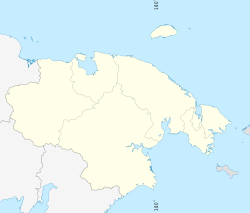Egwekinot
Urban-type settlement
|
||||||||||||||||||||||||||||||
|
||||||||||||||||||||||||||||||
|
||||||||||||||||||||||||||||||
Egwekinot ( Russian Эгвекинот , Chukchi Эрвыкыннот / Erwykynnot ) is an urban-type settlement in the Chukchi Autonomous Okrug in the far northeast of Russia . It has 2790 inhabitants (as of October 14, 2010).
geography
The settlement is located on the south coast of the Chukchi Peninsula , a good 30 km south of the Arctic Circle . It is about 250 kilometers as the crow flies in a north-easterly direction from the administrative center of the Anadyr Autonomous Okrug . The central part of Egwekinot extends on the west side of the 13 km long and 3 km wide bay of the same name at the extreme northern end of the Cross Bay (Saliw Kresta) , which in turn is part of the Anadyr Bay of the Bering Sea . Immediately behind the settlement, the mountains rise steeply to more than 700 meters. The district of Osjorny is about 10 km north.
Egvekinot administrative center is the Rajons Iultin .
Crossing the Arctic Circle through the road to Iultin and Mys Schmidta
history
In 1937 an important deposit of tin , tungsten and molybdenum ores was discovered in the central part of the Chukchi Peninsula, about 200 kilometers north of today's settlement Egwekinot . However, their development did not begin until after the end of the Second World War . For this purpose, Egwekinot was built from 1946, where a port was built to ship the ores. During the construction of the settlement, a road to the ore deposit, the mine there and the associated settlement Iultin (founded in 1953), prisoners from a camp set up for this purpose were used, which was subordinate to the Far Eastern camp administration ( Dalstroi ) in the Gulag system . The founding date of Egwekinot is July 16, 1946, when the first ship with 1,500 prisoners and other settlers arrived there. The camp existed until 1956.
In 1954 Egwekinot received urban-type settlement status. With the founding of the Iultin Rajons, it became its administrative center in the 1950s.
On May 30, 2008 the Rajon Iultin and the north adjoining Rajon Schmidtowski were combined into a new Rajon Vostotschny ("East Rajon"). Egvekinot remained its center. Since November 18, 2008 the new Rajon has been called Iultin again.
Population development
| year | Residents |
|---|---|
| 1959 | 3015 |
| 1970 | 3360 |
| 1979 | 4657 |
| 1989 | 5478 |
| 2002 | 2413 |
| 2010 | 2790 |
Note: census data
Economy and Infrastructure
During the Soviet period, Egwekinot was the transshipment point for the ores from the mine and also the basis for further, above all geological, exploration of the surrounding part of the Chukchi Peninsula. With the closure of the mine due to unprofitability in 1993, this function was lost, which resulted in a decrease in the population by more than half. Today there are only a few local supply companies. The Egvekinotskaya GRES thermal power plant with an output of 34 MW , which was built between 1950 and 1959 and reconstructed in 2010, is located in the district of Osjorny .
The settlement has a small seaport and four kilometers to the north an airport (official name - Saliw Kresta (Russian: Залив Креста ), ICAO code UHME ), which is served by Chukotavia from Anadyr.
Starting from Egwekinot, a largely unpaved road leads over 200 kilometers into the central part of the Chukchi Peninsula, over a nearly 500 meter high pass into the Amguema valley , one of the largest rivers on the peninsula, crosses it and ends at the former mining and Rajon administrative center of Iultin , which in the 1990s went from a settlement with over 5000 inhabitants (1989) to an uninhabited ghost town . From Iultin, an all-terrain vehicle track leads for more than 100 kilometers to the settlement of Mys Schmidta on the north coast of the peninsula.
Individual evidence
- ↑ a b Čislennostʹ naselenija gorodskich naselennych dotov, selʹskich naselennych dotov po Čukotskomu avtonomnomu okrugu. (Population of urban settlements, rural settlements in the Chukchi Autonomous Okrug.) Download from the website of the Chukchi Autonomous Okrug of the Federal Service of State Statistics of the Russian Federation
- ↑ Tschuktschen-ITL in the GULAG Internet portal of Memorial Deutschland e. V.
- ↑ Alexander Spiridonow: Egwekinot-1996 (article about the place and its history; Russian)
- ↑ a b Egwekinot on the website of the Geographical Institute of the RAN (Russian)
Web links
- Iultin Raion on the Autonomous Okrug Administration website (in Russian)




